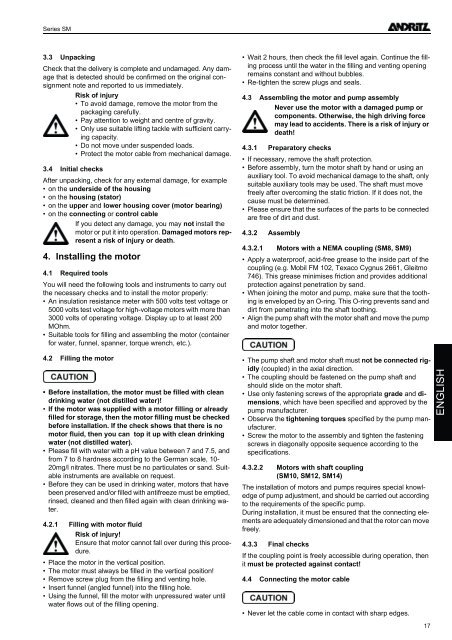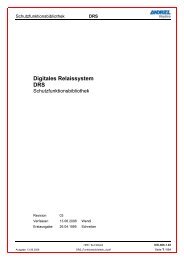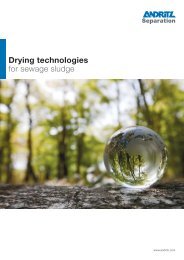Betriebsanleitung Operating Instructions Instructions de ... - Andritz
Betriebsanleitung Operating Instructions Instructions de ... - Andritz
Betriebsanleitung Operating Instructions Instructions de ... - Andritz
Create successful ePaper yourself
Turn your PDF publications into a flip-book with our unique Google optimized e-Paper software.
Series SM<br />
3.3 Unpacking<br />
Check that the <strong>de</strong>livery is complete and undamaged. Any damage<br />
that is <strong>de</strong>tected should be confirmed on the original consignment<br />
note and reported to us immediately.<br />
Risk of injury<br />
• To avoid damage, remove the motor from the<br />
packaging carefully.<br />
• Pay attention to weight and centre of gravity.<br />
• Only use suitable lifting tackle with sufficient carrying<br />
capacity.<br />
• Do not move un<strong>de</strong>r suspen<strong>de</strong>d loads.<br />
• Protect the motor cable from mechanical damage.<br />
3.4 Initial checks<br />
After unpacking, check for any external damage, for example<br />
• on the un<strong>de</strong>rsi<strong>de</strong> of the housing<br />
• on the housing (stator)<br />
• on the upper and lower housing cover (motor bearing)<br />
• on the connecting or control cable<br />
If you <strong>de</strong>tect any damage, you may not install the<br />
motor or put it into operation. Damaged motors represent<br />
a risk of injury or <strong>de</strong>ath.<br />
4. Installing the motor<br />
4.1 Required tools<br />
You will need the following tools and instruments to carry out<br />
the necessary checks and to install the motor properly:<br />
• An insulation resistance meter with 500 volts test voltage or<br />
5000 volts test voltage for high-voltage motors with more than<br />
3000 volts of operating voltage. Display up to at least 200<br />
MOhm.<br />
• Suitable tools for filling and assembling the motor (container<br />
for water, funnel, spanner, torque wrench, etc.).<br />
• Wait 2 hours, then check the fill level again. Continue the filling<br />
process until the water in the filling and venting opening<br />
remains constant and without bubbles.<br />
• Re-tighten the screw plugs and seals.<br />
4.3 Assembling the motor and pump assembly<br />
Never use the motor with a damaged pump or<br />
components. Otherwise, the high driving force<br />
may lead to acci<strong>de</strong>nts. There is a risk of injury or<br />
<strong>de</strong>ath!<br />
4.3.1 Preparatory checks<br />
• If necessary, remove the shaft protection.<br />
• Before assembly, turn the motor shaft by hand or using an<br />
auxiliary tool. To avoid mechanical damage to the shaft, only<br />
suitable auxiliary tools may be used. The shaft must move<br />
freely after overcoming the static friction. If it does not, the<br />
cause must be <strong>de</strong>termined.<br />
• Please ensure that the surfaces of the parts to be connected<br />
are free of dirt and dust.<br />
4.3.2 Assembly<br />
4.3.2.1 Motors with a NEMA coupling (SM8, SM9)<br />
• Apply a waterproof, acid-free grease to the insi<strong>de</strong> part of the<br />
coupling (e.g. Mobil FM 102, Texaco Cygnus 2661, Gleitmo<br />
746). This grease minimises friction and provi<strong>de</strong>s additional<br />
protection against penetration by sand.<br />
• When joining the motor and pump, make sure that the toothing<br />
is enveloped by an O-ring. This O-ring prevents sand and<br />
dirt from penetrating into the shaft toothing.<br />
• Align the pump shaft with the motor shaft and move the pump<br />
and motor together.<br />
4.2 Filling the motor<br />
• Before installation, the motor must be filled with clean<br />
drinking water (not distilled water)!<br />
• If the motor was supplied with a motor filling or already<br />
filled for storage, then the motor filling must be checked<br />
before installation. If the check shows that there is no<br />
motor fluid, then you can top it up with clean drinking<br />
water (not distilled water).<br />
• Please fill with water with a pH value between 7 and 7.5, and<br />
from 7 to 8 hardness according to the German scale, 10-<br />
20mg/l nitrates. There must be no particulates or sand. Suitable<br />
instruments are available on request.<br />
• Before they can be used in drinking water, motors that have<br />
been preserved and/or filled with antifreeze must be emptied,<br />
rinsed, cleaned and then filled again with clean drinking water.<br />
4.2.1 Filling with motor fluid<br />
Risk of injury!<br />
Ensure that motor cannot fall over during this procedure.<br />
• Place the motor in the vertical position.<br />
• The motor must always be filled in the vertical position!<br />
• Remove screw plug from the filling and venting hole.<br />
• Insert funnel (angled funnel) into the filling hole.<br />
• Using the funnel, fill the motor with unpressured water until<br />
water flows out of the filling opening.<br />
• The pump shaft and motor shaft must not be connected rigidly<br />
(coupled) in the axial direction.<br />
• The coupling should be fastened on the pump shaft and<br />
should sli<strong>de</strong> on the motor shaft.<br />
• Use only fastening screws of the appropriate gra<strong>de</strong> and dimensions,<br />
which have been specified and approved by the<br />
pump manufacturer.<br />
• Observe the tightening torques specified by the pump manufacturer.<br />
• Screw the motor to the assembly and tighten the fastening<br />
screws in diagonally opposite sequence according to the<br />
specifications.<br />
4.3.2.2 Motors with shaft coupling<br />
(SM10, SM12, SM14)<br />
The installation of motors and pumps requires special knowledge<br />
of pump adjustment, and should be carried out according<br />
to the requirements of the specific pump.<br />
During installation, it must be ensured that the connecting elements<br />
are a<strong>de</strong>quately dimensioned and that the rotor can move<br />
freely.<br />
4.3.3 Final checks<br />
If the coupling point is freely accessible during operation, then<br />
it must be protected against contact!<br />
4.4 Connecting the motor cable<br />
• Never let the cable come in contact with sharp edges.<br />
ENGLISH<br />
17







